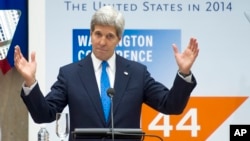Over the past decade, trade between the United States and the Americas nearly tripled. During the same period of time, the economies of Latin America and the Caribbean grew at a rate of 4 percent a year, lifting more than 73 million people in Latin America out of poverty. As Secretary of State John Kerry said, “this growth has lifted the lives of citizens.”
“It didn’t happen by accident. It happened by integrating markets, by incentivizing innovation, by creating new opportunities for citizens of all backgrounds. In short, it happened because leaders and institutions were willing to make the tough decisions to break away from the past, to try to make peace where there were insurgencies, and to open up new markets with trade agreements. They were prepared to commit to the future.”
The achievements of the past decade are impressive, and the countries of the Americas must continue to plan for the future.
Indeed, we must “develop a strategy to invest in the lasting, shared prosperity needed to lift up our section of the world for decades to come,” said Secretary Kerry.
Working together with our partners in the region, the United States will continue to invest in four specific areas to achieve these results.
First, we will invest in our people by making available to them a sound, outward-looking, globally oriented education.
Second, we can create good jobs for our graduates by opening our borders to trade and investment and creating opportunities for businesses to access international markets.
Third, we also continue to promote energy security, particularly through regional energy integration, to ensure that within a decade, every person in the Western Hemisphere will have access to the electricity they need.
And finally, we must invest in good, transparent governance, boost fragile institutions and reduce corruption.
“The 21st century can be a time of new definition of possibilities,” said Secretary Kerry. “If we work together and play our cards right, the Western Hemisphere can become literally the most stable and prosperous region in the world.”
“It didn’t happen by accident. It happened by integrating markets, by incentivizing innovation, by creating new opportunities for citizens of all backgrounds. In short, it happened because leaders and institutions were willing to make the tough decisions to break away from the past, to try to make peace where there were insurgencies, and to open up new markets with trade agreements. They were prepared to commit to the future.”
The achievements of the past decade are impressive, and the countries of the Americas must continue to plan for the future.
Indeed, we must “develop a strategy to invest in the lasting, shared prosperity needed to lift up our section of the world for decades to come,” said Secretary Kerry.
Working together with our partners in the region, the United States will continue to invest in four specific areas to achieve these results.
First, we will invest in our people by making available to them a sound, outward-looking, globally oriented education.
Second, we can create good jobs for our graduates by opening our borders to trade and investment and creating opportunities for businesses to access international markets.
Third, we also continue to promote energy security, particularly through regional energy integration, to ensure that within a decade, every person in the Western Hemisphere will have access to the electricity they need.
And finally, we must invest in good, transparent governance, boost fragile institutions and reduce corruption.
“The 21st century can be a time of new definition of possibilities,” said Secretary Kerry. “If we work together and play our cards right, the Western Hemisphere can become literally the most stable and prosperous region in the world.”















